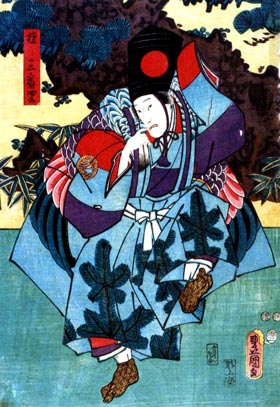| AYATSURI SANBASď |
| Dance titles | Ayatsuri Sanbas˘ Yanagi no Ito Hikuya Gohiiki |
| Authors | Minekoto Yajűr˘, Shinoda Sasuke (lyrics) Kineya Yajűr˘ V (music) Band˘ Sadajir˘, Nishikawa Senz˘ V (choreography) |
| History |
The dance "Ayatsuri Sanbas˘" was staged for the first time in the 8th lunar month of 1852 in ďsaka at the Chikugo no Shibai. The role of Sanbas˘ was performed by Arashi Rikaku II. The actor went to Edo the following year and achieved a great success by performing this dance, which was staged under the title "Yanagi no Ito Hikuya Gohiiki" in the 2nd lunar month of 1853 at the Kawarasakiza. |
| Key words |
Nagauta Okina Okina (N˘) Sanbas˘ Sanbas˘mono Senzai Shosagoto |
| Summary |
Many works are derived from N˘ theatre, and this particular Kabuki dance is one of them. The origin of this dance is "Okina" a petition for fortune and favor which is regarded as the most sacred production among N˘ pieces. In the N˘ dance are three characters; the okina, the senzai, and the sanbas˘. Okina is translated as "old man." Although Senzai, meaning 1,000 year-old man, is portrayed on stage as a man possessed of eternal youth. This character is often played by a handsome, young actor, despite the name's meaning. The sanbas˘ is the third and final character. "Sanba" is an abbreviation for sanban or "number three" and "s˘" can be translated as "person" or "man." So, the sanbas˘'s name can be said to mean "the third man." The okina and the senzai's dances are prayers for happiness and good fortune; while the sanbas˘'s dance is a prayer for a plentiful harvest for farmers or catch for fishermen. This was the original purpose of "Okina." The Kabuki version, "Ayatsuri Sanbas˘", is also regarded as an auspicious dance. Of course, just like the N˘ version, the okina dances first followed by the senzai, and the sanbas˘ is the last to take the stage. In the Kabuki performance, however, The sanbas˘'s dance is the highlight. Interestingly, while dancing to the shamisen accompaniment the sanbas˘ moves as if manipulated by strings, much like a puppet. In mid dance, it appears that a string breaks and he begins to dance clumsily. A stage assistant rushes out in a panic to mend it, and the dance continues. Some long-forgotten words adopted from the original N˘ dance are chanted during the shamisen accompaniment. As you may know, N˘ actors do not speak or talk on stage. All dialog is chanted by the chorus. Such enigmatic phrases as "tototarari totarari" and "osae, osae," can be heard at the okina's entrance. Even N˘ specialists have only a vague idea of what these words might mean, therefore, to an ordinary person, such words are completely meaningless, adding only to the ambience of the performance. As previously stated, there is no dialogue for actors in N˘ theater. One could argue that if actors spoke during the performance, reality would cast its long shadow onto the performance, destroying the subtle and profound characteristic of N˘. This Kabuki production of "Okina" closely follows the structure of the original N˘ performance. Pedantic observations aside, you can smiply enjoy the rhythmical, airy dances such as "Harvest" and "Bell", which provide the highlights for "Sanbas˘." Savor the enchanting dances of this fantasy world, as the performance will be finished before you know it. This summary has been written by Watanabe Hisao and edited by Jeff Blair [website] |
 |
|
Arashi Rikaku II performing the role of Sanbas˘ in the dance "Ayatsuri Sanbas˘", which was staged in the 2nd lunar month of 1853 at the Kawarasakiza (print made by Utagawa Toyokuni III) |
|
|
| Contact | Main | Top | Updates | Actors | Plays | Playwrights | Programs | Links | FAQ | Glossary | Chronology | Illustrations | Prints | Characters | Derivatives | Theaters | Coming soon | News |